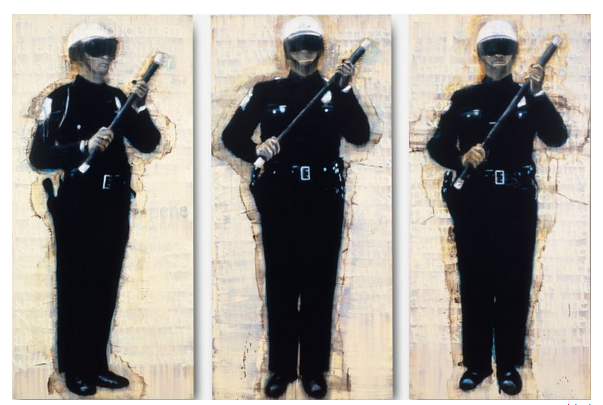At the Stanford Arts Review, we find the Andersons’ generous gift to Stanford a cause for both public and intimate celebration. We encourage you to visit the collection, force your expectations of art out the door and open yourself to discomfort. For what is modern and contemporary art, after all? Scribbles on a canvas, clean lines, exultations of color that arise in all their material glory from the human mind.
We now bring you a weekly series where our writers confront each painting and sculpture in the Anderson Collection, from 001 to 121. This week: Deborah Oropallo’s Three Man Patrol.
* * *

028. Megan Calfas on Deborah Oropallo’s Three Man Patrol
Why are you in riot gear? I don’t see no riot here! Why are you in riot gear? I don’t see no riot here!
The first step is always to show up.
But the painting isn’t here. I wandered around the Anderson Collection, weaving through tour groups and hushed contemplation. Echoes of sneakers and “Well, if you consider his early work…“ served as the backbeat to the sound of a security guard politely telling me that I should have left my backpack in one of the lockers downstairs. I followed her orders.
Three Man Patrol won’t be on display “until maybe springtime,” a docent informed me with an encouraging and apologetic smile. I sat down and stared at the blank wall between two paintings.
I thought I could use the painting to spark some conversation around the Stanford 68. In its absence, however, two guys around my age began discussing the protest, anyway.
“Hey, you know how some Stanford students blocked the San Mateo Bridge over the weekend? I almost went back that way. I would have been so mad sitting in that traffic.”
“Dude, yeah, that would have sucked.”
I listened, feeling both loyal to and guilty about the demonstration. I wasn’t there. On the bridge, I was also an unhung painting, full of potential to affect but unwilling to offer my time and presence to the cause. I was scared.
It was probably not a conscious choice on their part to leave this piece out, just as the artist, Deborah Oropallo, probably didn’t foresee its resonance when she finished it in 1993. Intention doesn’t necessarily dictate impact.
Maybe there’s something useful in the fact that this squad of patrolmen doesn’t get the chance to stare us down—searing into our eyes their poses of perpetual power, taking clarity and logic out of the equation.
Maybe there’s something lost in the unrealized opportunity for museum-goers to stare back and choose when to walk away.
For now, I’m stuck with mere possibilities, sitting at my computer, zooming in and out of a digital copy of the painting, listening to the news coverage of my friends’ bold voices, wondering how a single image could change things to be truly present.
